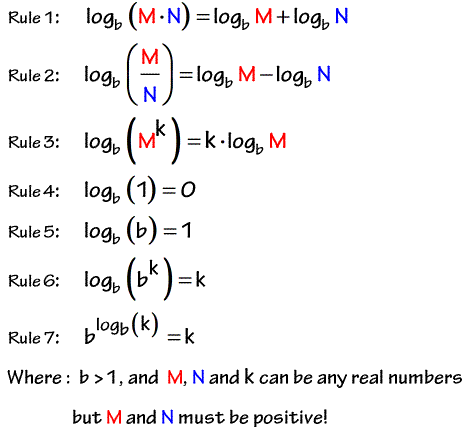
On the other hand, the logarithm with base n of n k is k, i.e., Taking the k-th power of a number n means: Just to be on the safe side, let's see an example. The difference is that with the root, it's not an exponential function that we're inverting but a polynomial one. However, we need to be careful here since taking the root can also be considered the inverse of an exponent. The logarithm is the inverse operation to taking an exponent, i.e., the inverse function to the exponential one. And instead of taking the power, we'd like to. Instead of multiplying, we'd like to divide. In other words, often, instead of adding, we'd like to subtract.

Useful as they are, it's sometimes useful to have addition, multiplication, and exponent work both ways. And instead of going further, let's stay with this one for a minute. But what if we go one step further and now want to multiply by the same number a few times? Again, there is a new way of writing that – the exponent. This new operation simplifies notation whenever we need to add the same number several times. The Napier constant, denoted by the letter ‘ e‘, is approximately equal to 2.718281828.Soon after we learn the basics of addition, they introduce us to multiplication. The natural logarithm of a number N is the power or exponent by which ‘ e‘ must be raised to equal N. For example, a substance’s acidity and alkalinity are represented in exponential terms. These logarithms are also known as Briggsian logarithms because British mathematician Henry Briggs invented them in the 18th century. If log N = x, then this logarithmic form may be represented in exponential form, i.e., 10 x = N.Ĭommon logarithms are widely used in research and engineering. Log N or log 10 N Decadic logarithms, and decimal logarithms are other names for common logarithms. The common log of a number N is as follows: The base of a common logarithm is always 10. The natural logarithm and the common logarithm There is our Change of Base Formula, where you can learn more about the base of the logarithm and its properties.

The natural logarithm has the number e as its base. The base of the logarithm is called the decimal or common logarithm. Learn more about with our Exponent and Dividing Exponents Calculators. Here you can see that the exponential function is also used. Potentiation allows each positive number as a base to have any real power and always gives a positive result. This implies that the log of a given number x is the type to which the second fixed number, base b, needs to be raised to deliver that number x. The logarithm represents the inverse function of potentiation.

Also, to add, substract or multiply logarithms, head to Condense Logarithms Calculator, and if you want to learn more about logarithms with base 2, you can see our Log Base 2 Calculator. In the text below, we have explained the basic things about logarithms and the history of logarithms themselves.

In this calculator, we will explain and make it easier for you to calculate logarithms. This Log Calculator (Logarithm) helps you to calculate the logarithm of a number with a random chosen base in the domain of a log function.


 0 kommentar(er)
0 kommentar(er)
